
Diuris pardina, commonly known as the leopard orchid or leopard doubletail is a species of orchid which is endemic to south-eastern Australia. It has two or three grass-like leaves and up to ten yellow flowers with reddish-brown marks and blotches.

Burnettia cuneata, commonly known as the lizard orchid, is the only species of the flowering plant genus Burnettia in the orchid family, Orchidaceae. It is a leafless terrestrial, mycotrophic herb with one or two leaf-like bracts and up to seven flowers that are brownish on the back and pink or white inside. It is endemic to southeastern Australia where it grows in dense thickets in swamps.

Calochilus, commonly known as beard orchids, is a genus of about 30 species of plants in the orchid family, Orchidaceae. Beard orchids are terrestrial herbs with a single leaf at the base of the plant, or no leaves. Their most striking feature is a densely hairy labellum, giving rise to their common name. Beard orchids, unlike some other Australian orchids, do not reproduce using daughter tubers, but self-pollinate when cross-pollination has not occurred. Most species occur in Australia but some are found in New Zealand, New Guinea and New Caledonia.
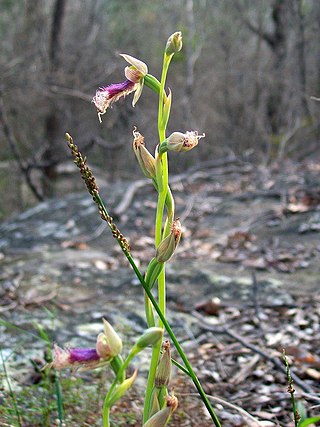
Calochilus robertsonii, commonly known as the purple beard orchid or purplish beard orchid, is a species of orchid native to Australia and New Zealand. It has a single dark green leaf and up to nine green to brown flowers with reddish or purplish stripes. The labellum has a glossy purple, mauve, or bronze-coloured beard with a ridge between the "eye" spots.
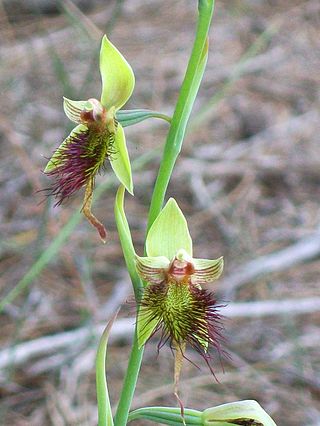
Calochilus paludosus, commonly known as the red beard orchid or red beardie, is a species of orchid native to Australia and New Zealand. It has a single fleshy, light green leaf and up to nine greenish flowers with reddish stripes. The labellum has a dull red or coppery coloured beard and lacks the "eye" spots of other beard orchids.

Bromheadia finlaysoniana, commonly known as the pale reed orchid and as Bromheadia pulchra in Australia, is a plant in the orchid family and is native to areas from Indochina to northern Australia. It is a terrestrial orchid with a tough upright, stem and stiffly spreading, elliptic to egg-shaped leaves. There is a long flowering stem with a short zig-zag section near the end where single flowers open in succession. The flowers are white with a yellow labellum.
Prasophyllum truncatum, commonly known as the truncate leek orchid, is a species of orchid endemic to Tasmania. It has a single tubular, dark green leaf and up to twenty whitish flowers with purplish and greenish-brown markings. It is a late-flowering leek orchid and its flowering is stimulated by earlier fire.
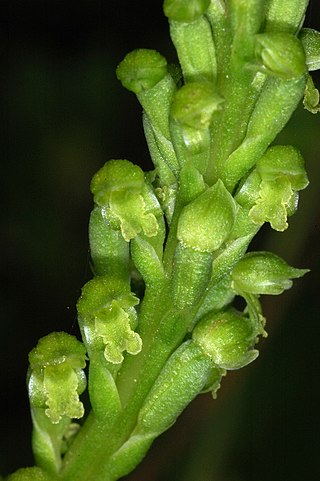
Microtis arenaria, commonly known as the notched onion orchid or pale onion orchid, is a species of orchid native to south-eastern Australia and New Zealand. It has a single hollow, onion-like leaf and up to sixty scented, crowded yellowish-green flowers. It is widespread and common, growing in a wide variety of habitats.
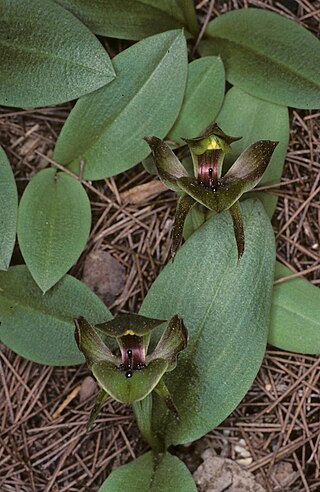
Chiloglottis gunnii, commonly known as the tall bird orchid, is a species of orchid endemic to Tasmania. It has two broad leaves and a single green to purplish brown flower with a line of erect calli with swollen heads along the mid-line of the labellum. It is widespread but mainly in coastal districts and most commonly in moist to wet forest.

Calochilus therophilus, commonly known as the late beard orchid, is a species of orchid endemic to eastern Australia. It has a single channelled, dark green leaf with a reddish base and up to fifteen dull greenish flowers with bold red stripes. The labellum has a dark purplish beard with two "eye" spots. Unlike that of other beard orchids, there is no prominent ridge between the eye spots.
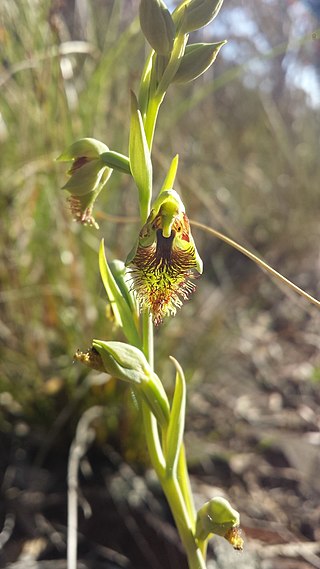
Calochilus therophilus, commonly known as the mountain beard orchid, is a species of orchid endemic to New South Wales and the Australian Capital Territory. It has a single fleshy, channelled, dark green leaf and up to fifteen green flowers with reddish lines. The labellum has two shiny metallic blue to purple plates near its base and there is no ridge between the two "eyes" on the column.
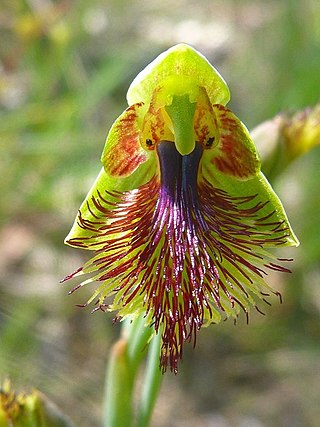
Calochilus campestris, commonly known as the copper beard orchid, is a species of orchid endemic to south-eastern Australia. It has a single fleshy, channelled leaf and up to fifteen pale green and red flowers with a purple "beard".
Calochilus caesius, commonly known as the blue beard orchid, is a species of orchid endemic to the Northern Territory in Australia. It has a single leaf which is not present during flowering and up to five pale green, very short-lived flowers with a bluish-red "beard".
Calochilus gracillimus, commonly known as the slender beard orchid or late beard orchid, is a species of orchid endemic to eastern Australia. It has a single dark green leaf with a reddish base and up to nine green flowers with red stripes and a reddish, brownish or purplish "beard".
Calochilus holtzei, commonly known as the ghostly beard orchid, is a species of orchid endemic to northwestern Australia. It has a single leaf and up to twenty pale green to yellowish flowers with red markings and a labellum with a greenish "beard".
Calochilus pruinosus, commonly known as the mallee beard orchid, is a species of orchid endemic to southern continental Australia. It has up to fifteen dull greenish, pinkish or brownish flowers with red lines and a labellum with a purplish "beard", but is leafless.
Calochilus pulchellus, commonly known as the pretty beard orchid, is a species of orchid endemic to the south coast of New South Wales. It has a single dark green leaf with a dark red base and up to five pale green to greenish yellow flowers with red striations and a labellum with a coppery red "beard". Fewer than thirty plants growing in three sites are known.
Calochilus richae, commonly known as the bald-tip beard orchid, is a species of orchid endemic to a small area in Victoria. It is a rare species, discovered in 1928 but not seen again until 1968 and its numbers are in decline. It has a single dark green leaf and up to five reddish brown flowers with darker stripes and a labellum with short, spiky, purplish "hairs".
Calochilus sandrae, commonly known as the brownish beard orchid, is a species of orchid endemic to the higher parts of southern New South Wales. It has a single greenish brown leaf with a reddish base and up to five brownish green flowers with red striations and a labellum with a brownish purple "beard".
Calochilus uliginosus, commonly known as the swamp beard orchid, is a species of orchid endemic to Western Australia. It has a single dark green leaf with a reddish purple base and up to seven greenish to brownish flowers with red lines and a labellum with a reddish purple beard.













